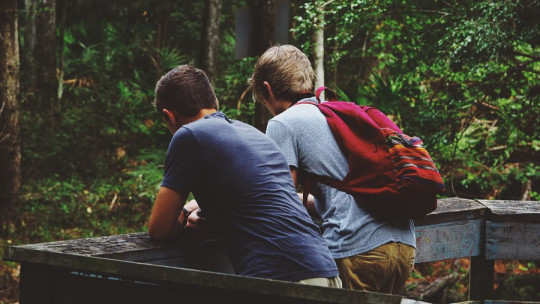Adolescence is a time of change, of transition to adulthood.
Adolescents begin to see how their bodies transform, their social norms change, the expectations that other people have of them change, as do their desires and responsibilities.
The same thing happens with your sexuality. The development of secondary sexual characteristics occurs from puberty and with this the adult sexual identity begins to be forged, which includes sexual orientation. That is, sexual desire arises, erotic desire in its adult version. This is when certain stimuli, such as the aforementioned characters, take on an erotic tone.
So, Teenagers can begin to enjoy all phases of the human sexual response : desire, excitement, plateau, orgasm and resolution.
Flirting in adolescence
In this wave of changes, the exploration of the world and the questioning of the adult-centred hegemonic vision become the axes of the search for one’s own identity and the forging of a unique personality To navigate this turbulent sea, friends emerge as the best possible comrades and fathers, mothers and other adults become rescue vessels to resort to when the impact of the waves endangers the integrity of the hull.
In this new exploration of the world they rehearse behaviors to test the limits (normative, moral, physical, social, etc.). These are experiments to assess which paths to take. Is about an approximation of what they consider they want to be as adults for which they usually use the trial and error method, which consists of carrying out an action and checking the result afterwards.
The search for new sensations on a sexual, physical and socio-affective level leads them to come into contact with their peers in intimate spaces in a format that is unknown to them.
They find themselves in a space that they have heard about, have seen videos or have read articles and above all a space of which they have created expectations that they try to fulfill. That is, they function as they have learned by collecting information from various sources such as conversations with friends, sexual education classes, family, the Internet, social networks or porn.
What is this space of intimacy like since March 2020?
We enter the space of intimacy in times of COVID, cybercourting or online flirting Especially at the beginning, he found himself restricted and limited to the virtual world.
In the last 20 years, the virtual world has been gaining ground in socializing and flirting. At first, Internet chats, phone calls or instant messaging were used. Little by little, social networks emerged in which to share content about tastes and life experiences. These were (and are) also used to meet new people and flirt.
After this, others specialized in sexual exchange emerged. The prominence of social networks has increased considerably due to the evolution of Smartphones since they allow you to carry a tool in your pocket with which to maintain social relationships, share content, meet new people and have virtual and physical sexual practices.
Well then, These virtual socialization networks have been the main scenario for social contact in the first months of the pandemic This has allowed adolescents to keep the flame of relationships of friendship, love and shared sex burning. Which is great news because they are in the moment of experimenting with other people different ways of locating themselves in the world as mature sexual beings.

What if these technological networks had not existed during the pandemic?
Who knows what the consequences would have been of suddenly repressing this need to be open to others and new experiences? It would surely have backfired, leading to psychological, social and emotional discomfort, disruptive or maladaptive behaviors with greater frequency and severity than those we have already begun to observe in clinic derived from the pandemic.
In any case, Cybercourting is very present in the lives of adolescents especially since the aforementioned month of March 2020. And what is this flirtation like?
A large part of adolescents is present on generic social networks (not oriented towards flirting) in which they share content of all kinds. This content is usually in video and photo format, and may be visible to third parties. These networks allow interaction with other people’s content and, on many occasions, commenting on it publicly or giving it a “like” serves to start a conversation via private messaging within the application itself. These interactions are frequently used as signals of sexual interest by the protagonist of the content
These virtual meetings allow people to get to know each other and exchange impressions before physically exposing themselves to an unknown person, which serves as a filter and personal preparation.
In these private communications, exchanges of messages or images of sexual content (sexting) may occur. Besides, The distance that the virtual world provides gives a feeling of security , facing the possible experience of vulnerability in physical contact. In these networks they can rehearse with different virtual identities (most have more than one profile in the same App), put into play different seduction strategies and games and learn to regulate their emotional-sexual world.
Another aspect to take into account is the type of content that is published and that there are frequently erotic or suggestive activities, challenges, poses or movements that attract the attention of potential partners. This eroticization of content, often made by minors, can also be found in chats and streamings (live broadcast of a game) of video games. The scenes broadcast may even turn out to be pseudo-pornographic.
Sometimes it happens that this content is not consciously eroticized by its protagonist, but is produced by imitation of other influential people who are successful on the Internet. Which can expose adolescents (especially girls) to abuse by those who see them as sexualized; Even more serious is when it is an adult (grooming). Besides, There is a danger that the content will spread over the Internet, lasting over time and reaching a multitude of unknown people
Despite these nuances, the content that teenagers upload is generally intentional. In fact, it is common to see how they let themselves be carried away by social desirability and present profiles, virtual identities, somewhat removed from reality or distorting it to show desirable characteristics and attract attention. In addition to these generic social networks, there are other specific ones for flirting.
There are even some designed for minors. Thus, we can find some that allow access from the age of 12 and whose profiles favor the anonymity of the participants, with the dangers that this entails. Some of these specific networks can be linked to other more generic and widespread ones, thereby increasing the radius of action exponentially.
Definitely
Applications and virtual social networks are doing a great job in maintaining relationships between adolescents , in addition to being a testing ground for emotional-sexual relationships. Although they also have a dark side, which entails a wide variety of risks that can affect their health. Therefore, we must encourage responsible use and know their virtual environments well, in addition to showing confidence and availability to be at their side with any problems that may arise.
Author: Borja Luque, General Health Psychologist and Sexologist.









